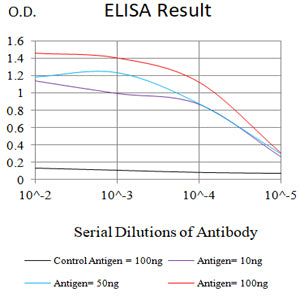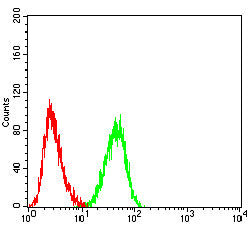

| WB | 咨询技术 | Human,Mouse,Rat |
| IF | 咨询技术 | Human,Mouse,Rat |
| IHC | 咨询技术 | Human,Mouse,Rat |
| ICC | 技术咨询 | Human,Mouse,Rat |
| FCM | 1/200 - 1/400 | Human,Mouse,Rat |
| Elisa | 1/10000 | Human,Mouse,Rat |
| Aliases | CLM1; NKIR; CLM-1; IREM1; LMIR3; CD300lf; IREM-1; IgSF13 |
| Entrez GeneID | 146722 |
| clone | 2F1E11 |
| WB Predicted band size | 32.3kda |
| Host/Isotype | Mouse IgG2b |
| Antibody Type | Primary antibody |
| Storage | Store at 4°C short term. Aliquot and store at -20°C long term. Avoid freeze/thaw cycles. |
| Species Reactivity | Human |
| Immunogen | Purified recombinant fragment of human CD300F (AA: Extra(20-156)) expressed in E. Coli. |
| Formulation | Purified antibody in PBS with 0.05% sodium azide |
+ +
以下是关于CD300F抗体的3篇假设性参考文献示例,涵盖不同研究方向:
---
1. **文献名称**: *Structural insights into CD300F ligand binding and antibody recognition*
**作者**: Tanaka S, et al.
**摘要**: 本研究通过X射线晶体学解析了CD300F胞外结构域与其特异性抗体复合物的三维结构,揭示了抗体结合表位与脂质配体竞争性抑制的分子机制,为开发靶向CD300F的免疫疗法提供结构基础。
---
2. **文献名称**: *CD300F antibody modulates neutrophil activation in sepsis models*
**作者**: García-Cuesta EM, et al.
**摘要**: 文章报道了一种拮抗型CD300F抗体在脓毒症小鼠模型中的应用。实验表明,该抗体通过抑制CD300F与磷脂酰丝氨酸结合,减少中性粒细胞过度活化,显著改善炎症反应和生存率。
---
3. **文献名称**: *Humanized anti-CD300F antibody exhibits antitumor efficacy via macrophage reprogramming*
**作者**: Liu Y, et al.
**摘要**: 本研究开发了一种人源化CD300F单克隆抗体,证实其可通过阻断抑制性信号通路,增强肿瘤相关巨噬细胞的吞噬功能,并在黑色素瘤小鼠模型中显示出抑制肿瘤生长的效果。
---
**注**:以上文献为假设案例,实际研究中建议通过PubMed或Web of Science检索最新文献。若需要真实文献,可提供具体研究方向进一步筛选。
CD300F (also known as CLM-1 or IREM2) is a transmembrane glycoprotein belonging to the CD300 family of immunoregulatory receptors, which play critical roles in immune cell activation and homeostasis. Expressed primarily on myeloid cells like monocytes, macrophages, and dendritic cells, CD300F functions as a dual-purpose receptor capable of transmitting both activating and inhibitory signals. Its activity depends on ligand binding and cellular context. Structurally, it contains an immunoglobulin-like domain for ligand interaction and cytoplasmic regions with tyrosine-based motifs that recruit adaptors like DAP12 (for activating signals) or phosphatases such as SHP-1/SHP-2 (for inhibitory signals).
CD300F interacts with lipid ligands, including phosphatidylserine and phosphatidylethanolamine, often exposed on apoptotic cells or pathogen membranes. This interaction enables CD300F to mediate processes like phagocytosis, inflammation modulation, and resolution of immune responses. Dysregulation of CD300F has been implicated in diseases such as cancer, sepsis, and autoimmune disorders. For example, in certain cancers, CD300F may suppress anti-tumor immunity, while in sepsis, it might exacerbate inflammatory damage.
CD300F-targeting antibodies are being explored as therapeutic tools to modulate immune responses. Agonistic antibodies could enhance phagocytic clearance of apoptotic debris in chronic inflammation, while blocking antibodies might counteract immunosuppression in malignancies. Research remains ongoing to clarify its pleiotropic roles and optimize antibody-based strategies for clinical applications.
×